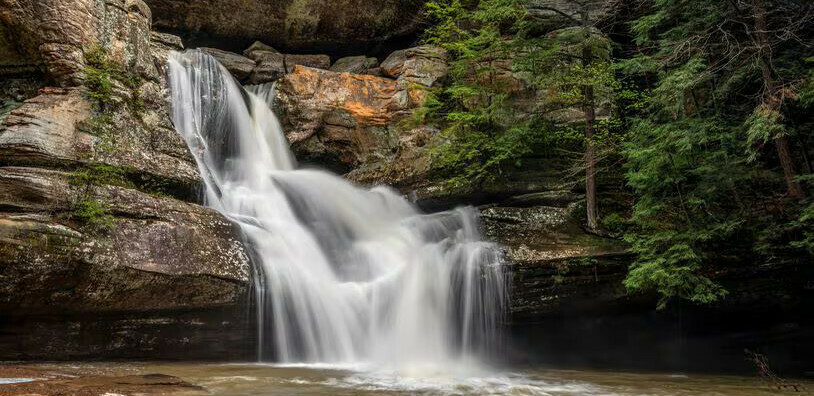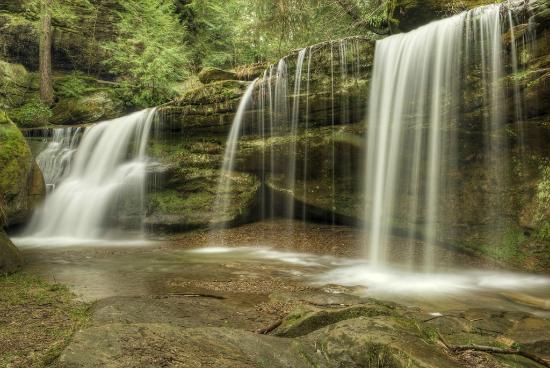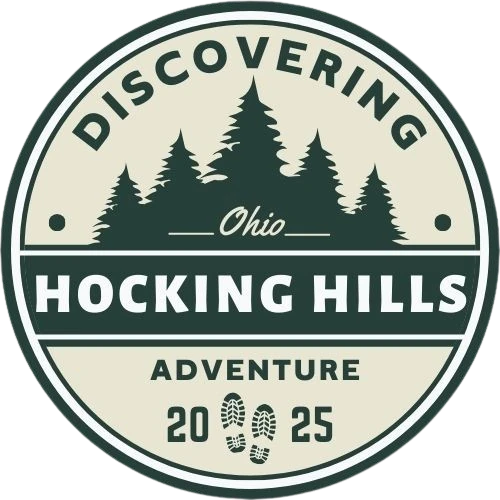Just around the corner from Old Man’s Cave, approximately 2 miles south on OH-374, you’ll discover Cedar Falls. It’s a natural wonder that has been drawing visitors for generations. This particular waterfall isn’t just another scenic spot, it’s a pivotal piece of Ohio’s natural heritage.

Table of Contents
- The Enigmatic History of Cedar Falls
- Navigating the Trails: Your Guide to Hiking Cedar Falls
- The Scent of Hemlocks: Unraveling the Naming of Cedar Falls
- General Park Information
This magnificent waterfall, which is well-known for its picturesque beauty and robust flow, is also the largest publicly accessible waterfall in Hocking Hills. The sight of water tumbling down over ancient, moss-covered sandstone rocks is not only visually amazing, but it’s also a testament to the power of geological processes that took millions of years to sculpt.
Cedar Falls has always been one of our favorite spots to visit in Hocking Hills, especially after a heavy rain when the majestic waterfall is flowing strong. When friends & family come to visit, if they are up for a hike, Cedar Falls is always at the top of our list of places to take visitors who have never experienced Hocking Hills before.
The Cedar Falls area was witness to the forceful glacial movements that shaped much of North America’s landscapes in the past. Those same ice sheets contributed to carving out the hollows and gorges that define Hocking Hills today.
The Enigmatic History of Cedar Falls

Cedar Falls’ history is interwoven with the very fabric of Hocking Hills State Park, and its story is as riveting as its beauty.
To truly appreciate a place, you need to delve into its origins and understand its history. The area around Cedar Falls was once a bustling hub for the Native American cultures, notably the Adena people, who left behind intriguing earthen mounds and artifacts. These historical traces provide insight into how the land was utilized centuries ago.
Fast forward to the 19th century, and Cedar Falls saw a new era of activity. European settlers discovered the practical and aesthetic allure of this region. The park’s establishment can be traced back to these times when the value of conserving such natural wonders became apparent.
Learning about the milestones that shaped Cedar Falls into the park we see today is not just about dates and events. It’s also about understanding the enduring relationship between humans and nature in this region. The preservation efforts that began over a century ago have allowed Cedar Falls to remain a pristine sanctuary for visitors year after year.
With this deeper historical context in hand, you can better appreciate the trails that wind their way through the park. So, as we transition from history to the present, let’s consider how the past has paved the way for the current network of trails.
Navigating the Trails: Your Guide to Hiking Cedar Falls

Visitors to Cedar Falls can immerse themselves in the lush scenery, forging a personal connection with the environment. Whether you’re a seasoned hiker or just looking for a leisurely walk, the trails here cater to all levels of expertise.
The trail at Cedar Falls is approximately 1 mile long, and fairly moderate from a difficulty perspective. However, the decent from either the main parking lot, or the smaller stone parking lot on OH-374, is quite steep with dozens of steps to traverse. The steps from the main parking lot tend to wash out after heavy rains, so the terrain can be a bit challenging, with steep drops and uneven surfaces to navigate.
Be sure to download a trail map, linked below, before heading out on any Hocking Hills adventures. There are additional trails that branch off from the Cedar Falls loop, which will take you on sections of the Buckeye Trail that lead to Rose Lake, Old Man’s Cave, and Whispering Cave, or to Ash Cave in the other direction.
As with all hiking excursions in Hocking Hills, we recommend you come prepared. Wear proper footwear to navigate the rocky and sometimes slippery terrain, carry sufficient water and electrolytes (like LMNT) to stay hydrated, and remember to check the weather before heading out. Cedar Falls is absolutely stunning and beautiful in the rain, but wet conditions can make the trails very muddy and slippery. A quality set of trekking poles will help you successfully navigate challenging trails.
If you want to see the falls at their most vibrant, consider visiting during the spring melt or after heavy rains, when the water flow is at its peak. On the other hand, the fall season cloaks the trails in spectacular shades of gold and amber, offering a completely different yet equally mesmerizing experience.
There isn’t really a bad time to visit Cedar Falls, but certain weather conditions and seasons can really enhance the beauty and awe-factor of your adventure.
And it should go without saying, but always practice “Leave No Trace” (LNT) principles.
The Scent of Hemlocks: Unraveling the Naming of Cedar Falls

One thing you are sure to notice almost immediately as you begin your decent into Cedar Falls from the parking area…the strong scent of cedar. Well, I have a little secret to reveal: despite its name, there aren’t any cedar trees around Cedar Falls. That’s right, the namesake of Cedar Falls isn’t what most people expect. Instead, it’s the native Eastern Hemlock trees that fill the air with their distinctive, cedar-like scent.
The confusion likely stems from early European settlers who mistook the hemlocks for cedars due to their similar smell. While the name might have stuck, today’s visitors are privy to the true identity of these majestic trees that have been a part of the landscape for centuries.
This includes understanding the crucial role hemlocks play in maintaining the ecosystem. These ancient trees not only offer a home to countless wildlife species but also play a part in controlling the climate of the surrounding ravines, making the trek to Cedar Falls unique no matter the season.
Whether you’re a history buff, a nature enthusiast, or just looking for a memorable outdoors experience, Cedar Falls in Hocking Hills State Park invites you to explore its trails, soak in its history, and enjoy the peaceful ambiance created by the towering hemlocks and the mesmerizing flow of the waterfall.
I leave you with this visual treat… The video below was taken in March 2017 after heavy flooding around Hocking Hills. This is a somewhat rare glimpse at what you might experience at Cedar Falls after a good downpour. Video credit goes to Dave Kovalcik.
General Park Information
Park Location:
- Cedar Falls
- 21560 OH-374, Logan, OH 43138
- GPS Coordinates: 39.4187073,-82.5246814
Hours:
- Half hour before sunrise to half hour after sunset.
Trail Maps:
- Distance: Approximately 1 mile
- Overall Difficulty Rating: Moderate
- AllTrails Trail Maps:
- Ohio DNR Site
Upcoming Events:
Take Nothing But Pictures, Leave Nothing But Footprints, Kill Nothing But Time
** A bit of transparency: Our website contains affiliate links. When you click through and purchase a product or service through any of our links, we may receive a small commission. Don’t worry, there is no extra cost to you. It’s a simple way you can support our mission to keep Discovering Hocking Hills and bringing you quality content to make your escape to Hocking Hills unforgettable! **
